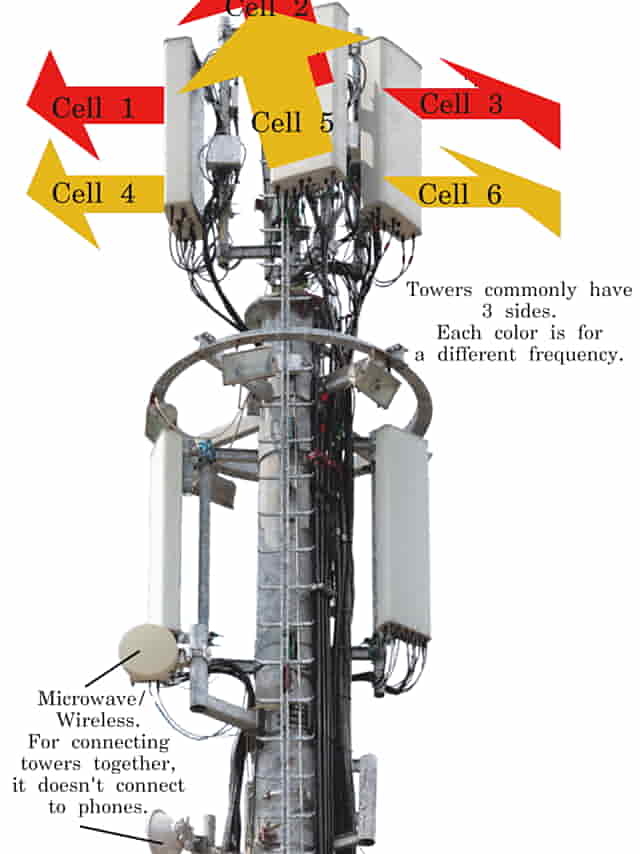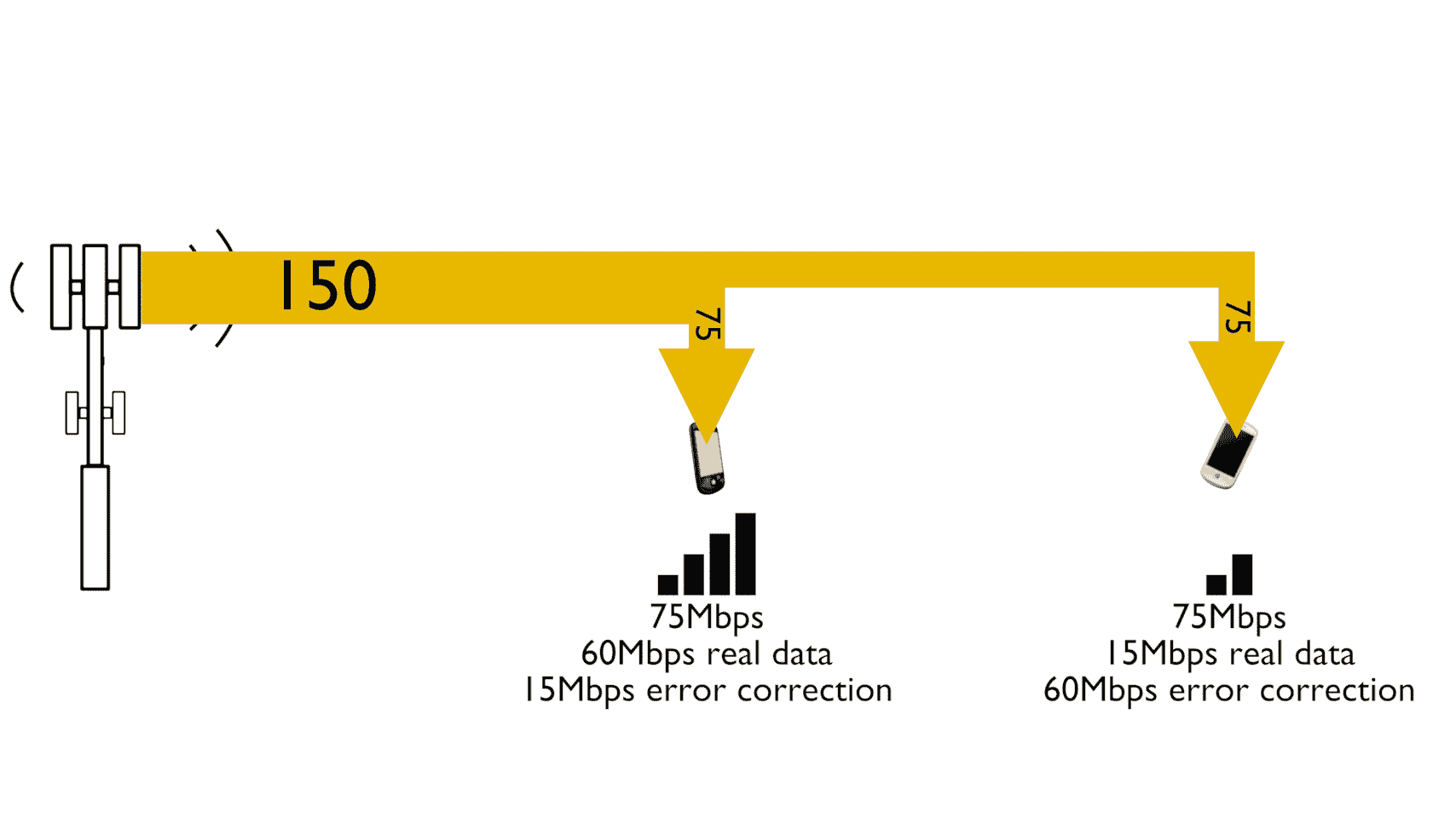4G speeds

A cell is the coverage from a part of the tower. Each side of a tower may have one or more frequencies, generally, each tower has 3 120-degree sides.
The primary cell is the main cell the phone uploads to and downloads from. The phone may be moved to another primary cell based on settings loaded from the tower, such as when the signal strength of the current primary cell is too weak.
Aside from the primary cell, the phone may use secondary cells so that multiple frequencies can be used at the same time, secondary cells are displayed as (S1), (S2), etc in the software.
Congestion
Each cell has a finite amount of resources.
If BW:10 is displayed in the software, there may be 75Mbps worth of download resources + 25Mbps worth of upload resources.
If BW:20 is displayed in the software, there may be 150Mbps worth of download resources + 50Mbps worth of upload resources.

If BW:20 is displayed in the software and 2 phones are downloading something, resources may be split this way or split in other ways. One phone is farther away, and its signal is worse, so more error correction is required.
Here, error correction is a simplification, and anything that isn't real data is considered error correction. In reality, there is 1. that what can actually be considered error correction data, 2. that fewer antennas will receive their own data when the signal is too poor, 3. the modulation order (complexity of communications) can be changed, 4. retransmissions i.e. 'Could you repeat that?' may be more or fewer.
Depending on the phone and the tower, it may be possible for the modulation order to be raised so that there is 200Mbps instead of 150Mbps, but the signal must be very good before 256QAM brings benefits.
For devices equipped with Exynos, the modulation order that can reach 200Mbps is displayed in the software as DL MCS:8. For devices equipped with Snapdragon, it is not displayed in the software. For devices equipped with MTK, it is displayed in the software as MOD(QAM): DL:256QAM.
Depending on the phone and the tower, there can be 4 antennas on each side instead of 2, there is then 400Mbps instead of 200Mbps. This is not always possible, depending on the band. Phones may have 4 antennas for bands similar to 1, 2, 3, 4, 7, 30, 38, 40, 41, or 66, but for bands similar to 5, 8, 12, 14, 17, 20, or 28 there are normally only 2 antennas in phones. For devices equipped with Exynos, MIMO RI is displayed in the software, there's approximately 100Mbps per MIMO RI if the DL MCS can be 8. For devices equipped with Snapdragon, PCC MIMO Configured indicates what's available. For devices equipped with MTK, it is not displayed in the software.
Uploading is always* done with 1 antenna, making it differ from downloading, which can be done over 2 or 4 antennas. So, in a 20MHz cell, resources available for uploading can be 50Mbps(16QAM or 4), 75Mbps(64QAM or 6) - with better phones and better towers, or 100Mbps(256QAM or 8) - with the best phones and the best towers.
On bands similar to 38,40, and 41, there is no pair of resources (upload+download), instead, the tower takes turns with phones.
*May differ with 5G.
If a cell is congested, it may be possible to switch to another cell that isn't congested. Move the phone around until the PCI and Earfcn/DL changes.
Interference
For example, if a phone is connected to Cell 6, but receives signal from Cell 4 or Cell 5, Cell 4 or 5 will cause interference, meaning there will have to be less real data and more error correction.
Other towers operating on the same frequency cause interference too, though it is often perceived that the more towers a phone receives signal from, the better the signal will be, the opposite is true.
The interference caused by other frequencies is relatively minimal, but may sometimes be significant, such as if a phone uploads at a high power while downloading.
The software displays the SNR or SINR. The signal strength is also available, but SNR or SINR is the signal quality. Therefore it can explain why the connection speed is slow even though there are 4 or 5 bars. A reasonable guideline is that the SNR or SINR should be positive, not negative, else the signal quality isn't good.
Internet connection of the tower
The tower must effectively be connected to the Internet for data to work. The speed of a tower's 'Internet connection' may be slow. Towers have microwave/wireless and/or fiber backhaul, these connect towers to the rest of the network, and then to the Internet. If X2 is available, towers may also interact with each other, directly, to improve the efficiency of moving phones to other towers while those phones are connected.
It is difficult to conclude that the tower's internet connection is slow by using the software. Check the software where the SINR or SNR (except SCell SNR) is consistently high (20+), if the RSRQ is abnormally high (near 0) during a download, then the tower's internet connection may be slow. Note that other phones that require a lot of error correction will skew the RSRQ, making it look like lots of data are downloaded, but the data being downloaded are mostly error correction.
Signal strength
If the signal strength is poor, data speeds will be slow. If the signal strength is at least okay, data speeds may be fast, and there are diminishing returns if the signal strength is improved further. Comparing the uplink signal strength at the tower with the downlink signal strength at the phone(RSRP, RSRP Diff, etc), the uplink signal strength tends to be weaker, is more important, and substantially affects battery life.
Data plan
The data plan, including without limitation the fine print of it, may affect data speeds.
Summary
Move the phone to find a spot where the topmost SINR or SNR is better, generally, the bigger this number, the higher the speeds. If the DL Frequency, PCI, or Earfcn changes, measure the speed again, the phone is now connected to something else. If the speed is slow, try to get the phone to connect to something else, e.g. by moving the phone until the signal strength of something else improves and the signal strength of the slow cell worsens.
